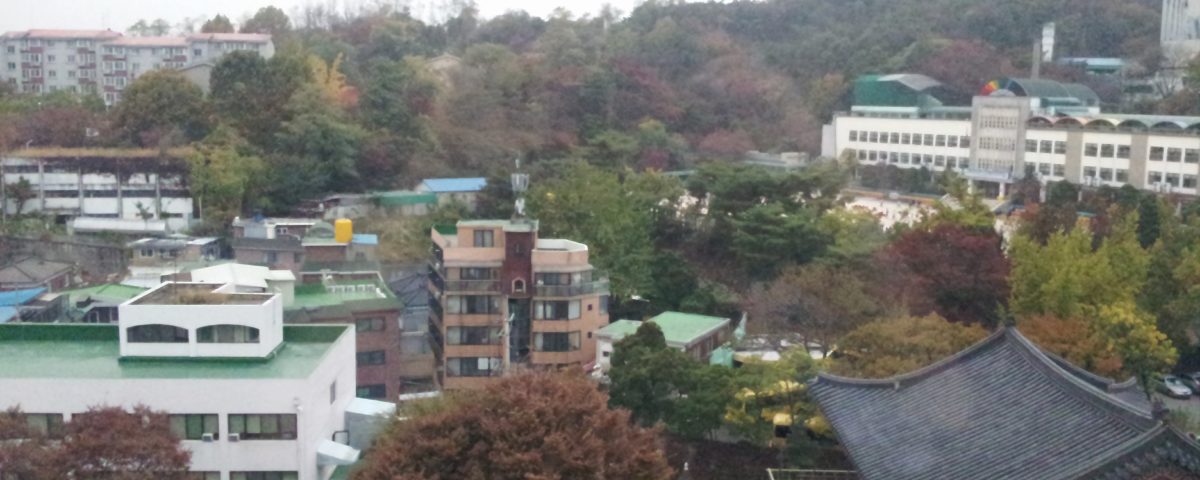Cram half the population of a country of 50 million people into a single metropolitan area of a mere ten thousand square kilometers, and personal space becomes a precious commodity [1]. So precious, in fact, that some people go to shocking lengths to protect it, as in the case of a Seoul resident who stabbed his two upstairs neighbors to death in 2012 because their footsteps were too loud [2].
Early-morning shivvings by space-starved neighbors did not number among my concerns before I moved to Seoul, but I did envision a densely packed city thronging with people pouring forth from every subway car and hole-in-the-wall restaurant, every treasured square meter accounted for with sky-high apartment buildings of infinitesimal partitions populated with doll-size furniture, rollout mats and mattresses, and lots of vertical cabinetry. I fancied myself living in something akin to the cupboard-under-the-stairs of Harry Potter yore—except without the large, wasteful stairs. Perhaps the only symbol of tight space missing from my mental portrait of South Korea’s capital was capsule hotels, probably because they were exclusively filed under “Japan” in my hippocampal world map along with weird vending machines,excessively cute women, and Hello Kitty Cafés.
I was wrong about a lot of things before coming to Seoul—including the lack of weird vending machines, excessively cute women, and Hello Kitty Cafés—but about refrigerator-sized rooms furnished with shoebox-sized refrigerators, I was right.
Of course, the fact that I spent my first eight months here living in a room the size of my college dorm’s bathroom—not a joke—wasn’t quite as much due to the sheer unavailability of other real estate options (as this video demonstrates, Seoul does boast its share of relatively expansive living spaces) as to the fact that I was a poor student living in a fairly expensive part of Seoul (Sinchon, where real estate prices are seasonally driven up by the decidedly non-poor students of Yonsei and Ewha Universities). However, I had been a similarly poor student in several other cities across the United States and China, and the same income bracket was able to rent out something in which I could safely sneeze without hitting my head against a wall. Okay, that is an exaggeration—but only a small one.
But at least the urban Korean real estate market, while comparatively expensive and plagued with often forbiddingly high deposits (the “key money” mentioned in our video) for even the most unassuming apartments, is a forgiving one, as it offers quite a few options for the penny-pinching individual, provided that she or he is not morbidly claustrophobic.
The first is the one-room (원룸), which is technically, as its name implies, a one-room studio. The choice of the name “one-room” over “studio” (which is also occasionally used) in a room listing, however, can imply very tight and spartan living quarters. As small as two dozen square meters or less, one-rooms can take tight living to the max, with a bed (or mattress space) abutting the stove against the bathroom door… you get the point. This makes constant cleanliness an imperative, as the prospect of a roach-infested kitchen becomes even less appealing when your kitchen is also your bedroom. One upside to the tight space, however, is that it takes little more than a nice fan to cool in the summer and very little heat (which usually radiates from the floor) for a comfortable winter.
Second is the hasukjib (下宿집/하숙집), which can be even smaller than some one-rooms, but, unlike private studios, are generally associated with common kitchen areas and therefore tend to consist only of a sleeping space and a bathroom. More like a long-term hostel than an apartment, hasukjibs do not require key money but may ask for a deposit of one or two months’ rent. They tend to cluster around universities as they cater to a primarily student clientele, but single young professionals, especially those whose families are from outside their city of residence, can and do also live there. They are sometimes run by kindly ajummas (older women) who may provide meals, or at least staples like rice, ramen, kimchi, and eggs, with rent. One blogger makes the excellent point that they are not always easy to locate online as the older Koreans who tend to manage them are not always the best about keeping up with technology [3].
Finally is a goshiwon (考試院/고시원) or the ostensibly-higher-end-but-actually-not-really goshitel (考試텔/고시텔). Both are similar to the hasukjib but generally without the friendly ajumma and free homecooked food that may be associated with her. They can be as large as a one-room or even small apartment, but, like the hasukjib, generally ask for only a small deposit rather than the ubiquitously bothersome key money. The most inexpensive of goshitels, like the smallest hasukjibs, can be extremely small, providing the very minimum amount of space—and fresh air, as some have only very small or absent windows—needed to live and almost none for storage. They can also be strict with their noise and visitor policies given the high density of exam-cramming students who might live there.
So that’s budget Korean apartment life in a nutshell—which is about the size of some elegantly designed real estate offerings here. But in one of the most densely populated cities in the world, we’re all probably better off with smaller and closer living spaces—as long as we keep our footsteps quiet enough for the neighbors.
This article was originally written for The Silk Road Project, now I Dig Culture, an international media channel that explores human cultural diversity and exchange.
